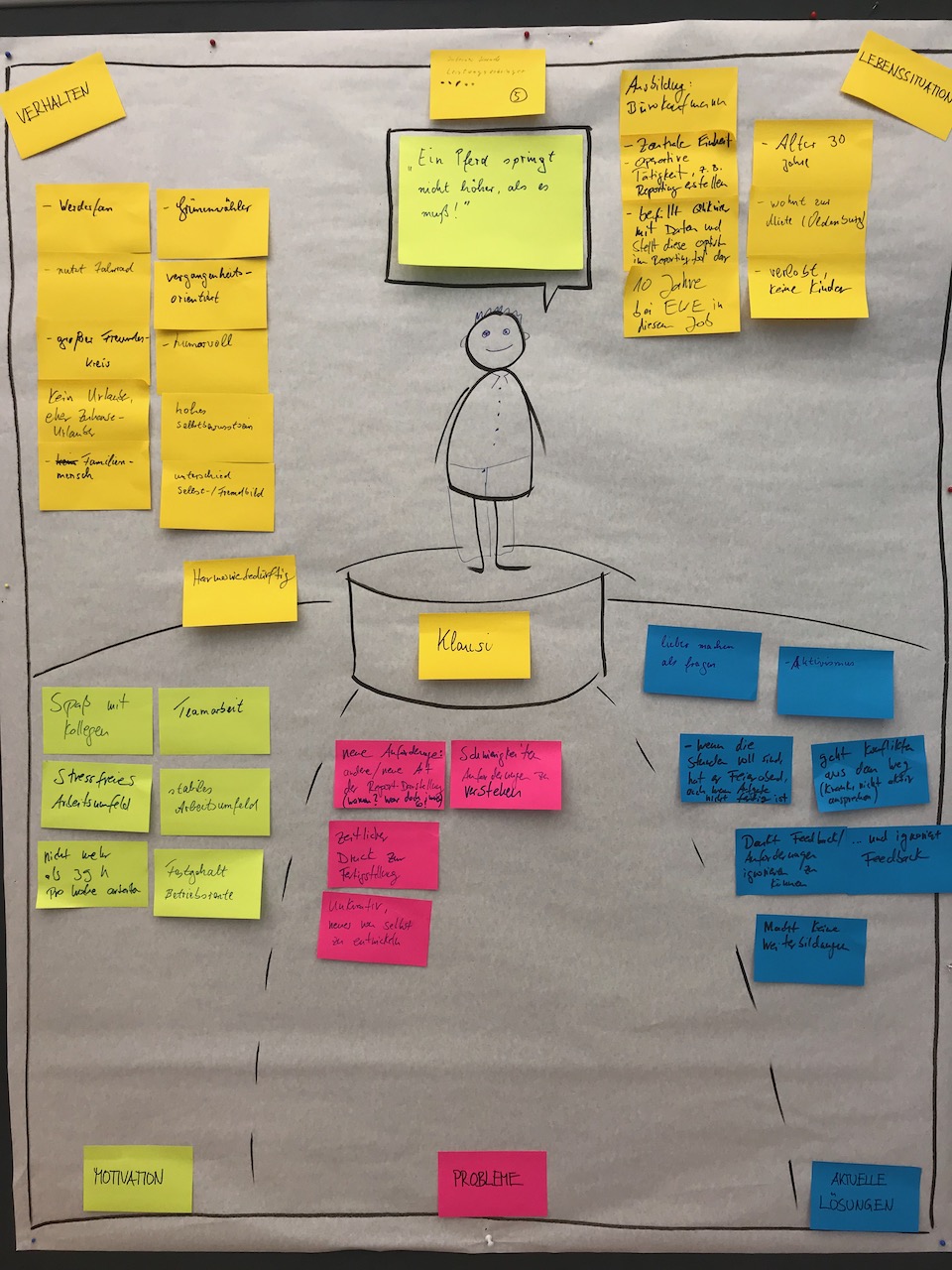What
Personas describe an archetypical User or Customer, with a focus on their motivations, the problems they encounter, and how they deal with them. They are based on surveys, interviews and personal experience, and provide just enough information about the user’s or customer’s socio-economic background and general behaviour to enable empathetic understanding of their perspective and needs.
Why
- Describe an archetypical user or customer in terms of their
- socio-economic background
- general behaviour
- motivations
- problems while pursuing the motivations
- ways of dealing with the problems
- Deepen the understanding of a specific type of user or customer
- Understand their perspective on a Product or Service
How
- Number of participants: 3–6
- Time needed: 45–60 mins for one iteration
- Material:
- Sticky notes in different colours
- Thick black markers
- Persona template
- A large board or wall space
- Timer
Personas help empathise with and take the perspective of potential users and customers. They take available data about socio-economic background and general behaviour, and turn them into vivid descriptions of an archetypical user or customer. They focus on their motivations, the problems they encounter, and how they deal with them, and allow you to tell stories about them.
You build a persona by filling the following template collaboratively, ideally in a group of 3–6 people:

Start with socio-economic background and general behaviour, using data from surveys, interviews and your personal experience. Don’t spend too much time here (~10 mins) – this section only provides background for the exploration of the persona‘s deeper needs. End this part with giving the persona a name.
Then drill down into the persona’s motivations (~10 mins), exploring what’s driving them, what they are looking and aiming for, what their deeper needs are. You can focus on concrete motivations in the context of your product, but also add deeper or overarching motivations. Visualise the hierarchy of motivations by using the vertical space available on the template.
For each of the motivations, think about the problems the persona encounters while pursuing it (~10 mins). Note them down and relate them visually to the motivations they impede. Again, go from concrete to abstract, exploring the whole range from task-related to overarching problems.
After this, describe how the persona is currently (i.e. without using your product) dealing with the problems (~10 mins). This section describes the alternatives the persona has to using your product. They can range from ignoring a problem or mitigating its effects to work-arounds and using competing products.
Finally, briefly summarise the persona’s situation and perspective in a slogan (~5 mins) – something they would say themselves, expressed in succinct way that helps you remember and communicate the persona.
Tips
- Use sticky notes to capture insights about the persona.
- Note first, discuss later.
- Be specific – use concrete details (e.g. about job, education, geographic location) and numbers (e.g. children, age, income) instead of broad categories or ranges. This helps make the persona vivid and enables you to empathise better.
- Avoid describing either the ideal customer or a negative caricature – try to stay true to what you know about the real people behind the persona, and keep empathising.
Where
- Can process output of: Interviews, Quantitative surveys, Empathy Map, Stakeholder Map
- Can feed input to: Stakeholder Map, Customer Journey Map, Problem Statement, Why-How Laddering, Design Studio
Caveats
In a business context, the use of this method can be implicitly consumerist – Customer-centric means consumerist most of time. When using the method, it should always be transparent whether the business goal is ultimately about creating new consumer needs or about improving how existing ones are being served.
Similarly, reducing people to the user or customer roles is a de facto ideological manoeuvre. When using the method, the personas explored should be accorded full humanity.
Provenance
The Persona concept was developed in the 1980s and 1990s by Alan Cooper in software and interface design, and Angus Jenkinson in brand marketing. It became popular and widely used in customer- and User-centric Design in the 2000s, evolving into countless variants and templates.
Contrary to the heavy focus on detailed descriptions in design and marketing Personas, the adaptation described here uses descriptions as a storytelling device to enable the exploration of deeper motivations, concrete problems and existing solution alternatives.